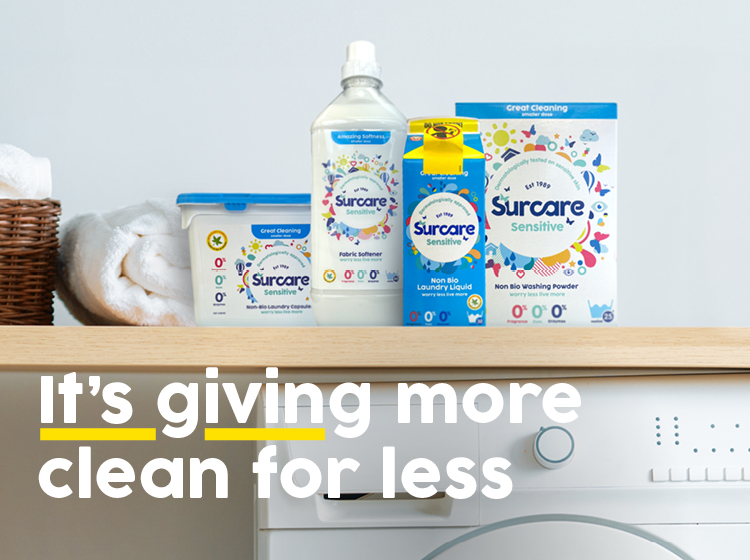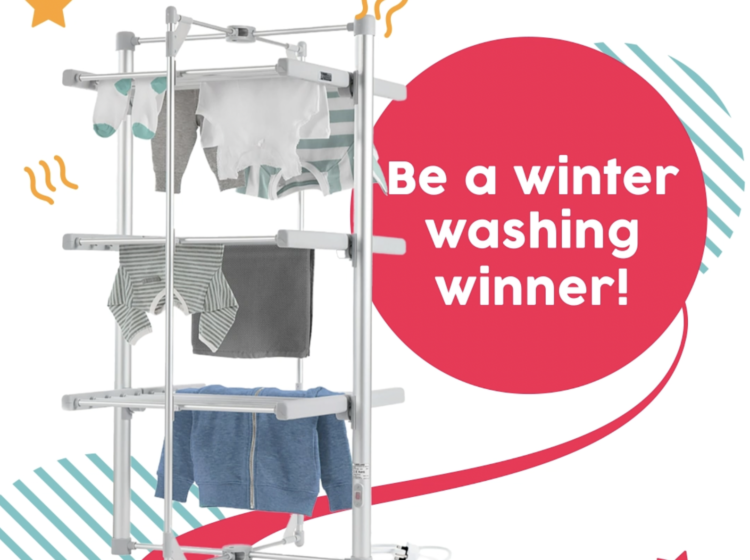As a parent it’s hard to watch your child be uncomfortable, distracted and in pain. If you have experienced eczema yourself, you know only too well the itch, poor sleep and time-consuming treatments involved with the condition. If you haven’t, the conflicting information online can be overwhelming. This article sets out common questions and worries to help you feel more confident in managing your child’s skin condition, and be hopeful for the future.
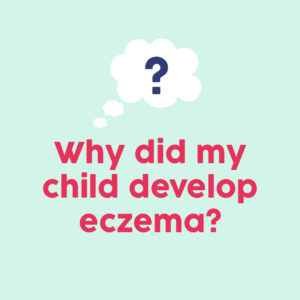
One in five children will have eczema at some point and it commonly starts in the first year of life. Two thirds of children will grow out of their eczema but for children with more severe symptoms, it can follow them into adult life. The most common type is ‘atopic eczema’. The term ‘atopic’ is used to describe a group of conditions; asthma, eczema and hay fever. Simply, the allergic part of the body’s immune system is more reactive to all sorts of allergens like dust and pollen. The skin barrier is weak too, meaning more moisture can escape, leading to dryness. This reactive skin barrier becomes easily inflamed (a flare) and then fluctuates with periods of calmness. Figuring out what causes these cycles can be frustrating as they are often driven by more than one trigger.
There are many benefits of working on controlling your child’s skin, first and foremost for their comfort, but research into the risk of allergies is interesting too. The weakened skin barrier has gaps, allowing allergens to pass through and cause inflammation when the body’s immune system ‘over-reacts’ to them. Research now tells us that this process can lead to development of an allergy, like egg, nuts or dust mites. Therefore, protecting the skin barrier from an early age, can help to reduce the risk of becoming sensitised to allergens.
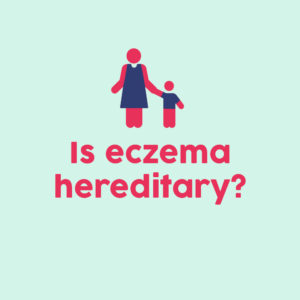
Why does my child have eczema?
There are lots of factors which are important in the development of eczema. It can run in families with some people lacking the gene to make filaggrin, a key protein in the skin barrier. The immune system then over-reacts to things that don’t usually do harm in our environment, which leads to dry and easily inflamed skin. If you have one child with eczema, there’s a 25% chance your next child will also develop it. Unfortunately, there is no cure, but it is attainable to manage symptoms and prevent flares ups, which will have a huge impact on your child’s life.
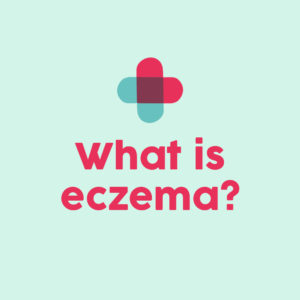
How do I know this is eczema?
Eczema is usually diagnosed by a GP spotting the classic symptoms of itchy, dry and inflamed skin. Getting an early diagnosis is important so the right treatment can be started. Although eczema can affect any part of the body, it appears in different places as your child gets older. In babies, it’s more common on the face, chest, legs and back of the head. From two years to puberty, it affects behind the knees, elbows, wrists, hands, ears and around the eyes and mouth. For teenagers, it can also affect the scalp and nipples. Eczema looks different in skin of colour and may look darker rather than red. It can also appear like small bumps or appear in different places. In areas that are scratched a lot, the skin can become thicker, which is called lichenification.
Scratching can further break down the skin barrier and allow germs to enter, leading to infection. If you notice weeping, crusting, swelling or spots, it may be infected, so see your GP straight away. It’s essential you get to know what your child’s flares look like, so you can spot changes early and notice when the usual treatments aren’t helping: you may need to see a doctor at this point.
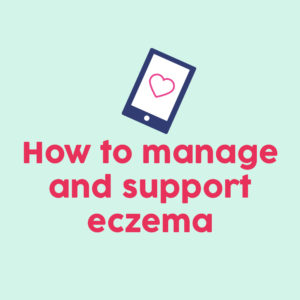
What can make my child’s eczema get worse?
The factors that can make eczema worse are called triggers. These vary from person to person and can be a challenge to identify. They may be something in the environment or things that come into contact with the skin like perfumed products. Some reactions happen straight away, but some can take a few days to cause a flare, so a symptom diary can be a great way to spot any patterns. There are a variety of free eczema trackers online and research has shown that 60% of parents who recorded skin appearance, treatments and triggers, noticed an improvement in their child’s skin.
Common triggers for you to consider –
- Changes in temperature, hot or cold weather
- Pet hair
- Pollen
- Teething in babies
- Dust and dust mites
- Stress, bullying, upset at home
- Laundry products
- Viral or bacterial infections
- Food allergy or intolerances
- Irritants like soaps, bubble bath, shower gel
- Fragrance in cleaning products and also airborne smells like candles
- Dampness at home or low humidity (dry air)
- Itchy clothing or materials that cause sweating
- Cigarette smoke, even on clothing if you smoke outside
- Swimming in chlorinated pools and wet or messy play
What is the role of food allergies in eczema?
Food allergies and eczema is a complex topic with many parents being worried that some foods are causing their child’s eczema. However, research shows that for the majority of children, food is not the cause or even a trigger.
There are two main types of food reactions seen in children with eczema. Firstly, immediate reactions when symptoms develop quickly after eating a food. Hives, itching, wheezing, diarrhoea or vomiting may occur. This requires a referral to an allergy specialist for further testing. The food itself is not causing the eczema but may be a trigger.
Secondly, there are delayed reactions which flares the skin 1-2 days after eating the food. Testing is less helpful and can result in foods being excluded from the diet unnecessarily. Children need a wide range of food to make sure they are getting all the nutrients they need, so in general excluding food groups is not recommended without medical advice. You can add food to your symptom diary to look for a pattern. Many parents worry about cow’s milk protein allergy in babies although it is rare for it only to present with eczema. Please see your GP to discuss this further.
Irritant eczema happens when eczema flares after your child’s face has been covered in food when they eat. It is common around the mouth. This is not a food allergy but happens because the food irritates the skin barrier. Applying an emollient before eating can help.
What can I do to help my child’s eczema?
When you first start managing your baby or child’s skin, it can feel like nothing is helping. Focus on repairing the skin barrier and remember that small shifts add up. Below are some helpful tips that will give you the confidence to keep going.
![]()
Emollients (moisturisers)
‘The best emollient is one you use regularly’. They moisturise the skin and form a protective layer to prevent water loss. There are gels, creams, lotions and ointments available on prescription. If one doesn’t feel moisturising enough or causes irritation, please speak to your GP as there are lots to try. More greasy emollients might be more suitable for night time.
Needing to apply emollients a few times a day is common as they usually last on the skin for up to six hours. The aim is to never let the skin feel dry or flaky. A rough guide is 250-500g per week for a child. That’s half to a whole tub! Emollients which contain ceramides, which are an essential part of the skin barrier, can be helpful.
Emollients work well on slightly damp skin so applying after bath time is a great option. Gently apply using clean hands, by layering them onto the skin in the same downwards direction as the hair grows. Stroke, never rub. It may take ten minutes for it to soak in.
A popular tip is to keep emollients in the fridge making them super cooling in summer months. Using a spatula or spoon to scoop them out is better than fingers which can introduce bacteria to the tub.
After a flare it can be tempting to stop moisturising, but having a hydrated skin barrier prevents further flares, so keep it up.
Paraffin based emollients are flammable so take care near any open flames. Also, greasier emollients can make the bath slippery, so remember to be extra vigilant.
![]()
Baths
Water can be drying for eczema skin especially in hard water areas. Hot water can cause itching when the skin over heats. Therefore, the aim of baths or showers is preventing water loss from the skin and minimising irritation.
Keep bath time less than 20 minutes and the water warm rather than hot. You can apply their emollient to the skin before a bath but beware of slipping! There are specific bath emollients available, but you can also just add a tablespoon of their emollient to the bath as it runs.
Remember bubbles, soaps and shampoos are drying to the skin and fragrances may cause irritation and itching. Soap substitutes clean the skin just as well and can be prescribed by your GP.
Apply moisturisers within a few minutes of bathing after patting the skin (never rubbing) so it’s still moist. This helps ‘trap’ in moisture to the skin barrier.
![]()
Itching
Itching is one of the hardest symptoms in eczema for children to understand and avoid. Scratching feels like it’s solving the problem, but it damages the skin barrier and releases histamine which causes even more itching. Habitual scratching occurs when the skin is not itchy but when your child is frustrated, sad or angry.
Try to keep nails short and encourage your child to rub or pat the skin rather than scratch.
Cotton gloves at night or scratch sleeves for babies can prevent unconscious scratching.
We’re all familiar with the art of distraction, and it can be useful when it comes to itching. Encourage your child to play with jigsaws and games that keep their hands busy. Notice the language you use when your child scratches. Try to avoid saying ‘don’t scratch’ and instead encourage then to ask for their emollient if they feel itchy. Reward this type of positive behaviour.
As we’ve mentioned skin is itchier when its dry, and during the night water is lost leading to increased chance of irritation. Applying emollients before bedtime is essential and should be made part of your evening routine.
Certain fabrics can be more cooling on the skin and prevent sweating which in babies can cause heat rashes. Cotton, silk and bamboo are preferable to man-made fibres or wool. Always check the labels!
Cold compresses, like a cold flannel can relieve the itch. Do not apply anything direct from the freezer as it can damage your child’s delicate skin.
There are many reasons why itching occurs and not all of this is driven by histamine. Therefore, anti-histamines are often ineffective. They should not be used routinely, although if the itch is allergen related e.g. after contact with pollen, they can be used to calm the flare. Sometimes a doctor may prescribe a sedating anti-histamine for a short time to help children sleep.
![]()
Laundry products
Think about how many hours your child’s skin is in contact with clothing and bedding! Contact irritation occurs when the skin gets irritated by a product or fragrance. This can lead to itching which further aggravates the skin barrier. SLS (sodium lauryl sulphate) is a detergent which makes products ‘froth’. It is found in shampoos, soaps, shower gels and cleaning products. It breaks down oils, disrupting and drying the skin barrier in sensitive skin. SLS free laundry products like Surcare can be kinder to sensitive skin.
Stronger fragranced products and those which contain dyes can also irritate. Surcare also has the Allergy UK seal of approval, awarded to products with reduced allergen content that have been dermatologically tested. Making the switch to a product like this is a great way to test out if your laundry products are irritating your child’s skin, and may be another part of the puzzle.
![]()
Creating an indoor ‘safe space’
As much as we want to, it’s impossible to wrap our children up in a bubble so they aren’t exposed to any allergens. Day to day, they will be exposed to airborne allergens like dust, pollen and a myriad of irritating fragrances. There are many changes you can make at home to reduce allergens, but a great focus is keeping their bedroom a ‘safe space’.
- Regularly wash pillows, duvets and blankets, minimum twice a year to kill dust mites
- Wash bedding at 60 degrees and vacuum mattresses weekly to remove dead skin cells
- Invest in allergy mattress and pillow covers
- Avoid feathers
- Ventilate their rooms in the morning by opening the window, which also helps to reduce mould. In pollen season, do this in the evening when the pollen count is lower
- Dust mites love warm and wet bedding so air duvets each morning before you make the bed
- Dust mites hang around on soft toys so keep them off their beds, wash regularly or put them in the freezer for 12 hours
- Declutter bedroom spaces and dust with a damp cloth to catch the dust rather than spreading it
- Aim for bedroom temperatures of 18 degrees to avoid over heating
- In pollen season, avoid drying bedding outside as pollen sticks to sheets
![]()
Sleep
We’ve all felt the wrath of a child who has had a bad night’s sleep and the impact it can have on the day ahead. This can lead to tiredness in the day, having impact on behaviour and ability to concentrate at school. Good sleep is also key for the function of the immune system, leaving skin more susceptible to infection. An unsettled nights sleep can also make scratching more likely, it’s a vicious circle.
The basics of good sleep start with a regular routine; going to bed at the same time, a quiet and dark bedroom, no screen time for two hours before bed, lots of natural light in the morning to set their body clock, no caffeinated products after midday and nightly baths to relax muscles and cool the body temperature.
![]()
Steroids
There is often caution in parents regarding use of topical steroids in children due to concern about possible side effects. I hope this article sets out various ways you can manage your child’s skin first without reaching for steroids as the first step. Sometimes, short topical steroid courses are needed to reduce the inflammation for 1-2 weeks. Emollients are key to prevent flares but leave around 30 minutes between applying steroids and a moisturiser.
I have eczema so can I prevent my baby getting it?
If you have eczema, the risk of your child developing the condition is increased and slightly higher if it’s Mum who’s affected. Breast feeding does not prevent eczema or food allergies but has many other benefits. Good news that it’s not necessary to exclude any foods from your diet unless you have been advised to by a doctor. The ‘Preventing food allergy in your baby; information for parents’ guidance describes an approach to earlier weaning at four months for babies at higher risk of food allergy or eczema. Please discuss this with your GP or health visitor.
Exciting research has shown some evidence that taking Lactobacillus Rhamnosus probiotics in the last three months of pregnancy, may prevent eczema in babies born to parents with eczema.

Apart from my GP or health visitor, where else can I look for help?
Most areas in the UK have access to community children’s eczema nurses, so ask your GP if they can refer you. They have more time to go through treatments, help find a cream that suits your little one’s skin and are especially helpful if treatments aren’t working. Sometimes referral to a dermatologist may be needed.
Let school know that your child suffers with eczema. The National Eczema Society have an information pack for schools, so they can be supportive, notice when your child is itchy and even remind them to apply their emollients themselves.
The National Eczema Society and Allergy UK are charities with lots of helpful resources and leaflets on their websites. Support groups like EOS www.eos.org.uk can connect you with other families going through the same thing and speak to people who understand the impact of eczema.
Life is tough, but so are you!
When something like eczema effects the centre of your world, it can be tough to say the least. No one likes to see their child frustrated or in pain, but the more reliable information you have, the better placed you are to help. It’s important to encourage your child not to dwell on their sensitive skin and although difficult, try to remain positive. Remember you’re not alone – having a child who suffers from eczema is another part of the parenting rollercoaster, which you are more than capable to ride out!
Join us for our next Instagram LIVE discussion with Dr Ruth on Instagram @SurcareUK on Wednesday 21st April 2021 @ 9pm where we will be talking about understanding eczema in babies and children.
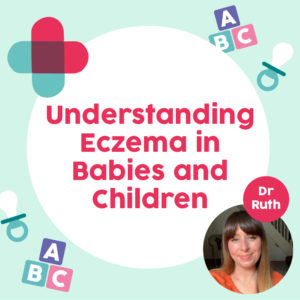
This blog post was produced through paid collaborative content with Dr Ruth Cammish – a GP, an eczema patient and loyal Surcare customer for over 20 years. She is the British Society of Lifestyle Medicine director for Manchester and is passionate about holistic health and lifestyle medicine. Follow Dr Ruth on Instagram @drruthskinjourney






























